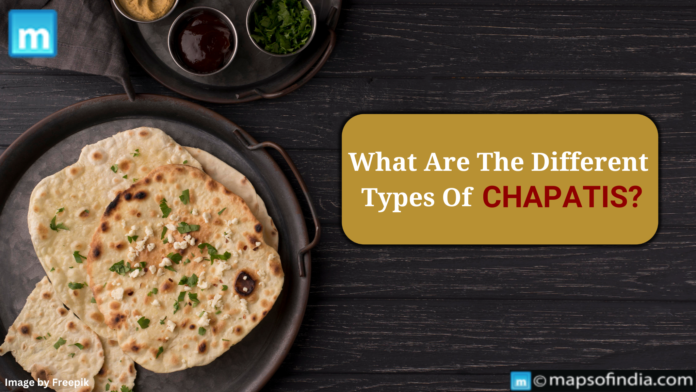In the colorful tapestry of Indian cuisine, the simple chapati reigns supreme. With its golden tint and smooth texture, this unleavened flatbread serves as the foundation of various meals, providing a blank canvas for unlimited culinary options. But the world of chapatis is far from uniform; it’s a symphony of textures and flavors, with each region claiming its distinct variations based on local ingredients and preferences. Let’s take a fantastic voyage through the wide world of Indian chapatis, studying the various flours that make them to life
Here are some different types of Chapatis:
-
Wheat Chapati: The Classic Canvas
The archetypal chapati, a North Indian staple, is made with whole wheat flour. These golden circles, fried on the tawa (griddle), have a chewy texture and a nutty aroma. They go perfectly with curries, dals, and vegetables, absorbing each bite’s flavors. Popular versions include:
- Roti: Larger and thicker than typical chapatis, rotis are a heartier option that can be loaded with potatoes or paneer.
- Phulka: Smaller and softer than ordinary chapatis, phulkas are frequently blown up while cooking to provide a light, airy alternative.
- Missi Roti: Infused with fenugreek leaves and spices, missi roti is a zesty twist on the traditional wheat chapati.
-
Millet Chapatis: A Gluten-Free Symphony
Gluten-free millets like Jowar, Bajra, and ragi are increasingly used to make chapati dough, providing a healthful and tasty alternative. These flours give the chapatis an earthy flavor and a slightly crumbly texture. Popular versions include:
- Jowar Roti: Made from Sorghum flour, Jowar roti has a somewhat sweet and nutty flavor that pairs well with spicy curries.
- Bajra Roti: Pearl millet flour adds a slightly bitter flavor to bajra roti, commonly paired with mashed vegetables like pumpkin or sweet potato.
- Ragi Roti: Made with finger millet flour, ragi roti has a thick and somewhat sour flavor that pairs well with coconut-based chutneys or lentil soups.
-
Rice Chapati is a Southern delicacy
Rice flour takes center stage in South Indian chapatis, providing a softer, slightly translucent texture. These chapatis frequently have mild, sweet, or savory aromas, making them excellent accompaniments to distinctive regional cuisines. Popular versions include:
- Dosa is a thin, crispy crepe prepared from fermented rice and lentil batter. It is frequently packed with potatoes or vegetables and eaten with chutneys and sambar.
- Appam: They are soft and spongy rice pancakes traditionally fermented and fried in a particular skillet, giving them a pleasant sour flavor.
- Pootharekulu: Sweet fried rice flour flatbreads are frequently laced with jaggery and cardamom, making them a favorite snack or dessert.
Beyond Wheat Belt: Exploring Regional Variations
The variety of Indian chapatis goes well beyond these classics. In Maharashtra, maize flour gives a distinct sweetness to “bhakri.” Kerala’s “pathiri,” prepared with rice flour and coconut milk, is delicate and fragrant. And in Goa, “Pao”, fluffy flatbreads made from semolina flour, are ideal for soaking up heavy seafood curries.
A Journey Through Flour and Flavor: Go on Your Culinary Adventure
The world of Indian chapatis invites you to explore, experiment with different flours and spices, and uncover the culinary riches inside each location. So take your rolling pin, preheat your tawa, and begin your delectable adventure through the vast world of Indian chapatis. Allow the textures to dance on your tongue, the flavors to pique your interest, and discover the symphony of flatbreads that awaits!





